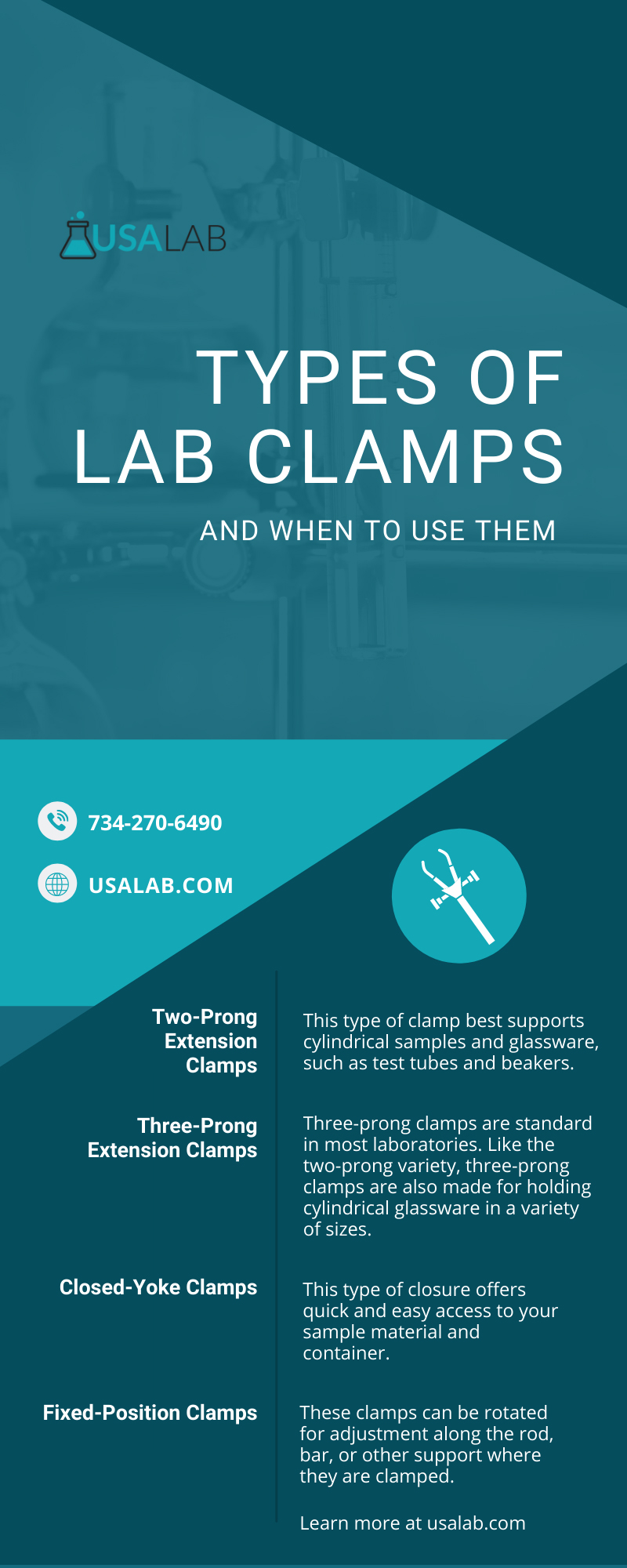Types of Lab Clamps | Clamp Uses in Laboratory | USA Lab
Posted by USA Lab Equipment on Mar 22nd 2022
When setting up your own laboratory space, there are many different pieces of equipment to consider stocking, some that you might forget until you need it. Lab stands and clamps are some of the tools that we often forget about but wouldn’t be able to function without in the lab. If you’re not sure where to start when it comes to stocking up on these parts, here are the types of lab clamps and when to use them in your own laboratory.
Types of Utility Clamps
Lab clamps, often known as utility clamps, have many different forms and purposes in the lab. Here are some of the different types of utility clamps and their applications for laboratory experiments.
Two-Prong Extension Clamps
As their name suggests, two-prong clamps feature two broad fingers or handles. This type of clamp best supports cylindrical samples and glassware, such as test tubes and beakers. Depending on the size of the clamp, the fingers of the clamp range from small and long to wide and broad. Smaller sizes of the two-prong utility clamps can be used to hold objects as small as thermometers and temperature probes. Two-prong clamps and three-prong clamps are some of the most commonly used clamp varieties in laboratories.
Three-Prong Extension Clamps
Three-prong clamps are standard in most laboratories. Like the two-prong variety, three-prong clamps are also made for holding cylindrical glassware in a variety of sizes. They feature two extended teeth on one end of the clamp and one on the opposite side’s end to hold your materials in place. Like most lab clamps, three-prong clamps are adjustable based on the size of the material you want to support and the length. This can be performed through a thumbscrew or wing nut adjustment. You may also find four-prong clamps with the same purpose. These clamps have the added support of an extra prong, featuring two on each side of the clamp.
Closed-Yoke Clamps
Closed-yoke clamps offer a different type of closure system than most lab clamps. This type of closure offers quick and easy access to your sample material and container. Yoke clamps also offer superior support while also minimizing contamination and corrosion. This type of closure is ideal for working with chemical samples. This is because they are easy to clean and operate, with no springs or internal workings to fight against during your experiments.
Fixed-Position Clamps
Fixed-position clamps don’t offer as many adjustment options as some of the clamps above. However, in an experimental situation where distance adjustments are unnecessary, fixed-position clamps offer the highest support. These clamps can be rotated for adjustment along the rod, bar, or other support where they are clamped. If you need to ensure your sample stays in one place for the duration of your experiment, fixed-position clamps are the way to go. Fixed-position clamps will hold your material at a 90-degree angle for precise measurements. These clamps are often used with burettes, thermometers, and condensers.
Clamps for Rods and Bars
You can also find specialty support clamps for your rods and bars. Boss heads are the type of clamps that hold rods and bars together. These clamps are highly adjustable to your needs, featuring metal or plastic screws. These types of clamps have several configurations based on how you need them to hold your lab equipment.
Ring Clamps
Ring clamps are another example of a specialty support for rods and bars. Ring clamps are sized for specific sample tools, such as perfectly encapsulating a cylindrical beaker. Ring clamps have superior thermal resistance and offer some of the most stability you can get out of a stand clamp.
Different Qualities of Lab Clamps
You can further customize your lab clamps to fit your needs through their various qualities. There are many clamp uses in laboratory settings you can use to your advantage. You can find almost any lab clamp in a variety of sizes, materials, and more that help it fit precisely to the application you have in mind. Keep reading to discover more about these different qualities of lab clamps and stands.
Size
As briefly mentioned above, lab clamps come in a range of sizes to fit the materials and space you’re working with. Most clamps range in size from small to large, and some even have specialty sizes tailored to unique pieces of equipment. For example, the clamps that support glass lab thermometers must be quite small to match the size of the equipment. Pronged clamps are some of the most variable in size for this reason.
Material Type
Laboratory-grade clamps also come in a variety of materials to fit different applications. Lab clamps usually consist of metal materials, including steel, pressed steel, cast iron, and stainless steel. Rods and lab stands usually consist of stainless-steel materials or aluminum alternatives. These metals sport heat and corrosion-resistant qualities, which are important when working with a variety of sample materials.
Coating and Lining
Finally, some lab clamps offer additional support through coatings or linings on the inside and outside of the clamp. You’ll usually find coatings along the teeth of two-prong, three-prong, and four-prong lab clamps, though almost any clamp can be outfitted with these coatings. Linings for lab clamps usually consist of rubber, cork, or vinyl to offer insulation and thermal resistance.
Where To Find Different Types of Lab Clamps
Now that you have a better idea of the diverse types of clamps you’ll need in the laboratory, all that’s left is to stock up your lab space. If you’re interested in purchasing stands, clamps, or rods for your own laboratory, check out our selection here at USA Lab Equipment. Here at USA Lab Equipment, we offer a wide variety of not only lab stands and clamps, but also many other types of lab equipment. Browse our selection of glassware and other items that pair with lab clamps to cover all the materials needed for your experiments.
We hope this deep dive into the distinct types of lab clamps and when to use them helps prepare you for all your future laboratory experiments. And if you’re in need of lab stands and other laboratory equipment for your workspace, don’t forget to check out our selection here at USA Lab Equipment. Whether you need lab stands, clamps, or extra glassware, you can find some in our online shop.


